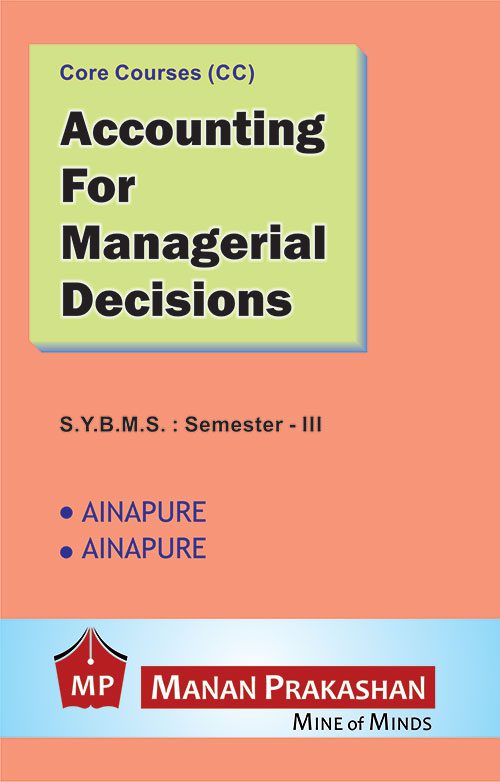Accounting For Managerial Decisions SYBMS
Semester III manan Prakashan
Unit -1 : Analysis and Interpretation of Financial statements : (15 Lec.)
1. Study of balance sheet of limited companies. Study of Manufacturing , Trading, Profit and Loss A/c of Limited Companies
2. Vertical Form of Balance Sheet and Profit & Loss A/c – Trend Analysis, Comparative Statement & Common Size
1. Study of balance sheet of limited companies. Study of Manufacturing , Trading, Profit and Loss A/c of Limited Companies
2. Vertical Form of Balance Sheet and Profit & Loss A/c – Trend Analysis, Comparative Statement & Common Size
Unit – 2 : Ratio Analysis and Interpretation (15 Lec.)
(based on vertical form of financial statements) including conventional and functional classification restricted to:
1. Balance Sheet Ratios : Current Ratio, Liquid Ratio, Stock Working Capital Ratio, Proprietory Ratio, Debt Equity Ratio, Capital Gearing Ratio
2. Revenue Statement Ratios : Gross Profit Ratio, Expenses Ratio, Operating Ratio, Net Profit Ratio, Net Operating Profit Ratio, Stock Turnover Ratio, Debtors Turnover, Creditors Turnover Ratio
3. Combined Ratios : Return on Capital Employed (including Long term borrowings), Return on Proprietors fund (Share holder fund and Preference Capital), Return on Equity Capital, Dividend Payout Ratio, Debt Service Ratio
4. Different modes of expressing ratios: Rate, Ratio, Percentage, Number. Limitations of the use of Ratios.
(based on vertical form of financial statements) including conventional and functional classification restricted to:
1. Balance Sheet Ratios : Current Ratio, Liquid Ratio, Stock Working Capital Ratio, Proprietory Ratio, Debt Equity Ratio, Capital Gearing Ratio
2. Revenue Statement Ratios : Gross Profit Ratio, Expenses Ratio, Operating Ratio, Net Profit Ratio, Net Operating Profit Ratio, Stock Turnover Ratio, Debtors Turnover, Creditors Turnover Ratio
3. Combined Ratios : Return on Capital Employed (including Long term borrowings), Return on Proprietors fund (Share holder fund and Preference Capital), Return on Equity Capital, Dividend Payout Ratio, Debt Service Ratio
4. Different modes of expressing ratios: Rate, Ratio, Percentage, Number. Limitations of the use of Ratios.
Unit – 3 : Cash Flow Statement (15 Lec.)
Preparation of Cash Flow Statement (Accounting Standard-3 (revised))
Preparation of Cash Flow Statement (Accounting Standard-3 (revised))
Unit – 4 : Working Capital (15 Lec.)
Working Capital :
Concept, Estimation of requirements in case of Trading & Manufacturing Organizations
Receivables Management :
Meaning & Importance, Credit Policy Variables, methods of Credit Evaluation (Traditional and Numerical – Credit Scoring); Monitoring the Debtors Techniques [DSO, Ageing Schedule]
Working Capital :
Concept, Estimation of requirements in case of Trading & Manufacturing Organizations
Receivables Management :
Meaning & Importance, Credit Policy Variables, methods of Credit Evaluation (Traditional and Numerical – Credit Scoring); Monitoring the Debtors Techniques [DSO, Ageing Schedule]
Additional Information
| BOARD | Mumbai University |
|---|---|
| ISBN | 978-93-88626-55-2 |
| AUTHOR | Ainapure & Ainapure |
| PUBLISHER | Manan Prakashan |
| ED | All |
| PAGES | 432 |
| SUBJECT | Accounting For Managerial Decisions SYBMS Semester III |
| LANGUAGE | English |


Reviews
There are no reviews yet.